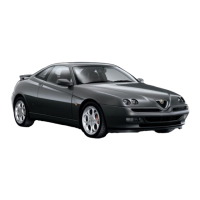Do you have a question about the Alfa Romeo 4C Spider 2020 and is the answer not in the manual?
Guidance on consulting the Table of Contents and the Index for information retrieval.
Guidance on using the Table of Contents and Index for finding desired information.
Explanation of colored labels and symbols indicating precautions for vehicle use.
Details on operating procedures that could lead to collision, injury, or vehicle damage.
Warning that modifications can affect safety and roadworthiness, potentially causing injury.
Information on the key fob, mechanical key, locking/unlocking doors, and battery replacement.
Procedure for key removal and notes on ignition switch positions.
Explanation of the Sentry Key system preventing unauthorized vehicle operation.
Details on arming and disarming the vehicle's security alarm system.
Information on central door locking, unlocking, and emergency locking devices.
Instructions for adjusting front seats forward/rearward, height, and recline.
Details on non-adjustable head restraints and their safety function.
Instructions for adjusting the tilt and telescoping steering column.
Details on automatic dimming, outside, and heated mirrors.
Operation of multifunction lever for headlights, DRLs, high beams, and turn signals.
Details on interior light timing and operation modes.
Instructions for operating windshield wipers, washers, and mist function.
Overview of the climate control system buttons and functions.
Details on operating climate controls, including temperature, blower, and mode settings.
Instructions for operating power windows, including automatic and reset functions.
Step-by-step instructions for removing the vehicle's soft top.
Procedures for starting the engine, including automatic transmission operation.
Explanation of engaging gears (Forward, Reverse, Neutral) and operating modes.
Procedure for starting a cold or warm engine without pedal intervention.
Information on operating the engine at low temperatures and associated cautions.
Warnings and cautions regarding engine starting procedures and fuel.
Guidelines for breaking in new drivetrain components and transmission modes.
Instructions on applying and releasing the parking brake lever.
Details on using the transmission, including paddle shifters and operating modes.
Explanation of the Alfa DNA system modes (Dynamic, Natural, All Weather, Race).
Procedure for activating high-performance acceleration from a standstill.
Instructions for activating, setting, varying, and deactivating Speed Control.
Information on parking sensor operation, acoustic signals, and display indications.
Details on the rear view camera image display and guide lines.
Instructions for opening the fuel filler door and refueling the vehicle.
Information and warnings regarding trailer towing with the vehicle.
Guidelines for towing the vehicle behind a motorhome.
Advice for safe driving on slippery surfaces like snow, ice, or wet roads.
Cautions and warnings regarding driving through standing or flowing water.
Contact information and procedure for obtaining roadside assistance.
Instructions on activating and using the hazard warning flasher for emergencies.
Lists interior and exterior bulbs, their numbers, and locations for replacement.
General information on fuses, warnings, and precautions for replacement.
Information on using the tire service kit for temporary tire repair and its components.
Step-by-step guide for jump starting a vehicle with a discharged battery.
Steps to reduce overheating, including A/C and heater usage.
Information on using the front tow eye for towing and related precautions.
Details on the automatic oil change indicator system and wrench warning light.
Overview of required maintenance intervals based on mileage or time.
Conditions that require more frequent checks and maintenance.
Checks to perform monthly or before long trips, and required maintenance intervals.
Guidance on changing engine oil and selecting the correct oil and filter.
Information on proper maintenance intervals and selection of engine air cleaner filters.
Recommendations for air conditioner service, including condenser cleaning.
Guidance on lubricating body pivot points, locks, and hinges.
Instructions for cleaning and replacing windshield wiper blades.
Procedure for adjusting windshield washer nozzles and checking fluid.
Importance of exhaust system maintenance and inspection for safety and performance.
Precautions to minimize catalytic converter damage and maintenance requirements.
Procedures for checking, draining, flushing, and refilling the cooling system.
Recommendations for using and adding the correct engine coolant (antifreeze).
Importance of periodic inspection of brake system components for performance.
Checking and maintaining the brake master cylinder fluid level.
Procedures for checking and adding the correct type of brake fluid.
Guidelines for selecting and maintaining transmission fluid for optimal performance.
Covers tire markings, identification numbers, terminology, pressures, and loading.
Explanation of the various codes and symbols found on tire sidewalls.
Details on tire size designations (P, European, LT) and examples.
Explanation of Load Index and Speed Symbol for tires.
Location and explanation of the Tire Identification Number, including the date code.
Definitions of terms like B-Pillar, Cold Tire Inflation Pressure, and Tire Placard.
Information on vehicle load capacity, tire sizes, and inflation pressures from the placard.
Procedure to calculate the vehicle's cargo and luggage load capacity.
Impact of tire pressure on safety, fuel economy, tread wear, and ride comfort.
Guidance on checking and adjusting tire pressure, including cold inflation pressure.
Recommendations for maintaining tire pressure during high-speed driving.
Warning against mixing radial ply tires with other types due to handling instability.
Conditions under which a tire may be repaired, including puncture size and location.
Details on Run Flat tires, their limitations, and when they need replacement.
Warning against spinning wheels excessively when stuck to prevent tire damage.
How to use tread wear indicators to determine when tires need replacement.
Recommendations for using equivalent tires in size, quality, and performance for replacement.
Information on All Season tires and their proper use in sets of four.
Information on Summer tires and when to install Winter tires.
Guidelines for selecting and using snow tires, including speed rating limitations.
Notes on spare tires, including compact and collapsible spares.
Precautions and limitations for using compact spare tires.
Precautions and limitations for using collapsible spare tires.
Recommendations for cleaning wheels and wheel trim to maintain luster and prevent corrosion.
Recommendations for using tire chains, including size and installation.
Information on tire rotation possibilities and specific tire recommendations.
Explanation of UTQG grades: Treadwear, Traction, and Temperature.
Steps to protect the battery and air conditioning system during storage.
Guidance on protecting the vehicle body from corrosive elements and weather.
Common causes of vehicle body corrosion, such as road salt and insects.
Procedures for cleaning headlights and general underbody maintenance.
Recommendations for washing the vehicle, including specific cleaners and avoiding power washers.
Tips for driving on dusty roads, cleaning drain holes, and touching up paint chips.
Instructions for cleaning fabric upholstery and carpeting using Mopar Total Clean.
Guidelines for cleaning seat belts and when to replace them.
Instructions for cleaning vinyl upholstery and plastic instrument cluster lenses.
Recommendations for cleaning leather upholstery using Mopar Total Clean.
Guidance for cleaning all glass surfaces, including the inside rear window and mirrors.
Location and importance of the Vehicle Identification Number.
Description of the dual hydraulic brake systems and their function.
Proper lug nut/bolt torque specifications for wheel mounting.
Recommended gasoline octane rating, spark knock, and quality considerations.
Benefits and recommendation of using cleaner burning reformulated gasoline.
Recommendations for gasolines with detergents, corrosion, and stability additives.
Warning against using gasoline with methanol or more than 10% ethanol (E-10).
Warning about the risks of using E-85 fuel in non-compatible vehicles.
Information and recommendation against using gasoline containing MMT.
Guidelines for maintaining vehicle performance and avoiding fuel system damage.
Precautions to prevent carbon monoxide poisoning from exhaust gases.
Table listing approximate US and Metric capacities for fuel and engine oil.
Recommendations for engine coolant types and specifications for the 1750 Turbo Engine.
Recommendations for SAE 5W-40 API Certified Synthetic Engine Oil.
Recommendation to use Mopar Engine Oil Filter for replacement.
Recommendation to use Mopar Spark Plugs and adhere to replacement intervals.
Requirements for fuel octane rating and ethanol content.
Fluid specifications for Alfa Twin Clutch Transmission and Brake Master Cylinder.
Details on vehicle connectivity, security features, and software updates.
List of components for the vehicle's radio system, including speakers.
List of components for the optional Hi Fi audio system.
Advice on mobile phone interference with radio performance.
Tips for preparing for service appointments and making reasonable requests.
Guidance on contacting authorized dealers and the manufacturer's customer center.
Information on FCA US LLC warranties applicable to the vehicle.
Information on Mopar parts and accessories available from authorized dealers.
Procedure for reporting vehicle safety defects to NHTSA and FCA US LLC.
Information on ordering service and diagnostic procedure manuals.
| Brand | Alfa Romeo |
|---|---|
| Model | 4C Spider 2020 |
| Category | Automobile |
| Language | English |












